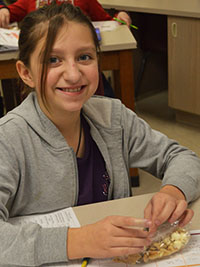YMCA educator Elizabeth Kinsman picked up a cardboard container of Pop-Tarts that said “low-fat.”
“Someone would pick this up and say, ‘Hot-diggity-dog, I’m doing a healthy thing,'” Kinsman told Comstock Park Mill Creek Middle School students.
But two Pop-Tarts come in a pack, and devouring both means lots of calories and sugar. Many people don’t realize a serving size, as noted on the box label, is just one pastry.
“A lot of people want to end up being healthy and try being healthy, but they don’t know how to use these labels,” she said. “Things can be advertised as really, really healthy but if you eat four times the serving size it might not be healthy anymore.”
Knowing how much to eat, and making healthy food choices, requires math and reading skills and simply paying attention, Kinsman recently told Mill Creek sixth-graders during one of her six-week sessions. As part of teacher Donita Coughlin’s health class, students learned how to read nutrition labels and easily incorporate healthy snacks into their diets.
Sometimes a six-cracker serving size posted by a manufacturer is unrealistic, Kinsman stressed. So for an accurate picture of calories and fat, those numbers must be multiplied.
The best part of her twice-weekly visits: taste-testing fun food packed with nutritional ingredients. Students sampled popcorn trail mix loaded with dried cherries, Chex mix and whole-grain goldfish.
“There’s a stigma that healthy food is gross,” Kinsman said. “We give them different ideas, fun ideas with foods that are obtainable to students cost-wise.”
Good Habits Support Good Health
The YMCA’s Nutrition in Action Program started in 2006 to provide hands-on nutrition education to vulnerable children and families to increase consumption of whole grains, low-fat dairy products, fruits, and vegetables. Schools where 50 percent or more students qualify for free or reduced lunch are eligible. Educators currently visit schools in the Wyoming, Grand Rapids, Kentwood, Kelloggsville, Lowell and Godfrey-Lee districts.
As part of the program, students try foods like mango, papaya and spinach, fruit crisp made with berries, and fruity whole-grain waffles. “We’re trying to set those behaviors in our lives,” Kinsman said. “We all have good and bad habits. We need good habits for our health.”
 Coughlin also teaches about healthy habits, paying attention to labels and eating breakfast, so Kinsman’s lessons complement and solidify her classes.
Coughlin also teaches about healthy habits, paying attention to labels and eating breakfast, so Kinsman’s lessons complement and solidify her classes.
“Many of my students don’t have an adult in their world that maybe supports this kind of information,” she said.
The class has had an impact on sixth-grader Michael Schaafsma, for one. “I’m eating whole-grain stuff at home,” he said.
CONNECT








